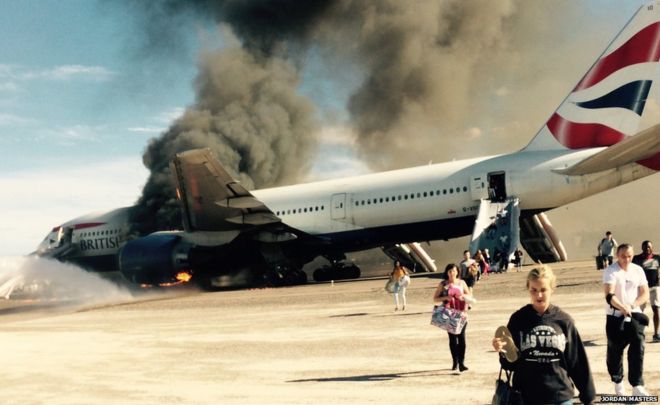
Posted on 09/09/2015
What the British Airways Engine Fire Teaches Us About Airline Safety
While investigations into the exact cause of the fire continue, the process of the emergency evacuations is also coming under critique.
An engine fire during take-off of a British Airways plane recently caused a billowing black cloud of smoke and a frantic emergency evacuation on the tarmac at Las Vegas’s McCarran International Airport. British Airways flight 2276 was a nonstop service from Las Vegas to London’s Gatwick Airport, operated by a Boeing 777-200.
No major injuries or fatalities resulted after the flight crew expertly aborted the take-off and brought the aircraft to a stop, nevertheless, airport officials said at least 14 people were taken to hospital with minor injuries.
In a statement, British Airways said the aircraft “experienced a technical issue as it was preparing for take-off”. The plane was seen engulfed in flames and smoke. The fire was later put out.
While investigations into the exact cause of the fire continue, the process of the emergency evacuations is also coming under critique. Cabin crew are taught and practice, during initial and recurrent extensive training, to forcefully yell repeated commands during an emergency to override any confusion and shock. Though the script varies from airline to airline, these instructions typically include the order to “leave everything,” and passengers are consciously disobeying this, to the potential risk of their own and other’s lives.
So how can you easily remain ready for an aircraft emergency without looking paranoid? We have some tips:
1. Keep your shoes on until after take-off, and put them on again before landing. Why?… Just imagine you may have to evacuate barefoot, which can result in minor injuries.
2. Do not attempt to evacuate with luggage or bags. If you’d (understandably) like to have your ID/passport and wallet and phone with you, either keep them in a pocket on your body or pack a small zip case which you can easily stash in your waistband or pocket when it’s time to get out. This keeps your hands free and eliminates any extra risks you’d encounter by trying to leave while hauling belongings. OR There’s always the Hawaiian shirt approach.
3. Pay attention to the pre-flight safety briefing. If you’ve been through one, you’ve been through them all, right? Wrong, as aircraft types, layouts, and situations change from flight to flight and the safety briefing is essentially your free guide to getting out unharmed and alive in case of emergency.
4. Obey the cabin crew. An emergency is a confusing, high-adrenaline event and crew are trained to take charge despite panic. Listen to their commands and be prepared to move quickly, however they instruct.